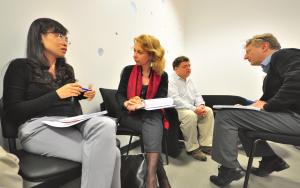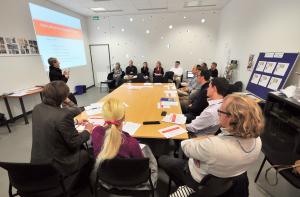35 nations, 40 languages ... which culture?
On the banks of the Durance River, halfway between Aix-en-Provence and Manosque, a unique community has taken root—some 500 people from 35 countries who have arrived with their languages, cultural references, traditions and work habits.

Some are physicists. Others are secretaries, engineers, accountants, administrators or specialists in a multitude of areas. Many come to ITER from the research laboratories of the ITER Member states ... others from industry or international organizations.
While the oldest have been working for the last 30 years toward fusion energy, the youngest were just coming into the world when the ITER Project was officially launched at the end of 1985.
English—the official working language of the ITER Organization—is the native language of just 15% of staff. But to truly understand one another, a common working language is not sufficient. That's the difficulty—and the beauty—of multiculturalism at ITER.
With the exception of the United Nations such a diversity of languages, origins and cultures is not easy to find. And there's an important difference. Staff at the UN work for the country they represent, whereas at ITER, whatever the country of origin, every person is mobilized toward the same objective.
"To work at ITER is to be confronted daily with the "difference" of the person across the hallway," explains Shawn Simpson, who organizes workshops, seminars and events dedicated to "interculturality" within the Organization. "And the pitfalls ... both linguistic and cultural ... are numerous."
Translated into the lingua franca of ITER, a "yes" or "no," or a simple "I would like, please," can be quite heavy with meaning and expectation depending on whether the words were pronounced by someone from Japan, China, the United States, India, Russia, Korea, or southern or northern Europe.
A friendly gesture from one person may be construed as overly familiar by another. The raising of one's voice—a common occurrence in one part of the world—may be felt by members of another culture as aggressive and intolerable.
And as for emails (tens of thousands are exchanged each day within the Organization), they can also be a mirror of cultural values and traditions and, as such, the cause of serious misunderstanding. Take the formal, polite formulations that are de rigueur at the beginning and ends of emails in some cultures. For some, this is an indispensable sign of respect; for others, such elaborate formulations are seen as superfluous and long-winded.
Hierarchical relationships also vary from one culture to another—flexible and friendly for some ... more rigid and formal for others.
"Mutual understanding in an organization like ITER is only possible if each person is willing to regularly question his or her own values," says Shawn, an American born in Vietnam and raised in (among other places) France, Nigeria and Australia. "When problems occur, it's always a question of ego, irrespective of nationality."
Despite what she calls the "minefields" that are a regular part of intercultural life, the men and women of ITER understand one another. Better still, each person can be enriched by the differences encountered. "We are constantly learning from one another and, as a result, we are learning about ourselves. It's an extraordinary thing to be part of such a rich environment ..."
From the moment the first ITER Organization employees settled into temporary offices on the CEA research centre site in 2006, an "ITER culture" began to take root, enriched naturally by every newly recruited staff member from the ITER Member nations. "When today I see Americans attending a performance of traditional Japanese dance, I think to myself—interculturality truly works at ITER!"
The grandest human enterprises, scientific or otherwise, will all be founded in the future on broad international collaboration. What men and women are inventing daily at ITER may be too young yet to be considered a model. But it's an experience that is sufficiently enriching and unique to already be the object of interest on the part of other international organizations.


